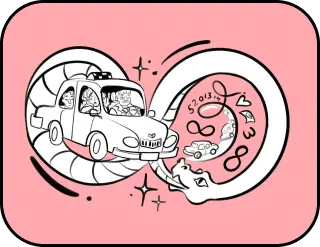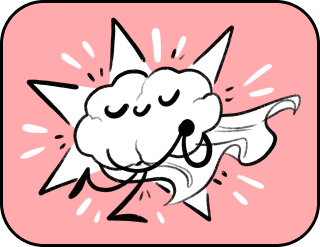Category: Materialization technologies
THE PARADOX OF FEAR: WHAT LIES BEHIND GREAT INVENTIONS
“Normality is a paved road: it’s comfortable to walk, but no flowers grow on it”
Vincent van Gogh
Every breakthrough has two biographies: the official one, written for history books, and the secret one—where, alongside scientific calculation, you’ll find quiet terror and obsessive thought listed among the co-authors. These are the stories of the unceremonious side of invention, of geniuses who tamed their personal demons and put them to work for humanity.
We invite you to step into the laboratories where the darkest fears became unique lenses through which the light of great discoveries shone. Let us clarify: we are not reducing the genius of inventors to a diagnosis; we simply wish to show how a deeply personal, sometimes painful peculiarity could become a strange but powerful catalyst for thought.
Get ready. It’s going to get tense.
NIKOLA TESLA: THE DEMON OF NO CONTACT
His demon was invisible and omnipresent. It crawled at his fingertips, multiplied in the folds of tablecloths. Nikola Tesla’s fear of germs was not mere squeamishness—it was true obsession, closely resembling modern obsessive-compulsive disorder. Handshakes were ordeals followed by hours-long cleansing rituals. In restaurants, Tesla demanded 24 napkins (his magic number!) to wipe every piece of silverware until it shone.
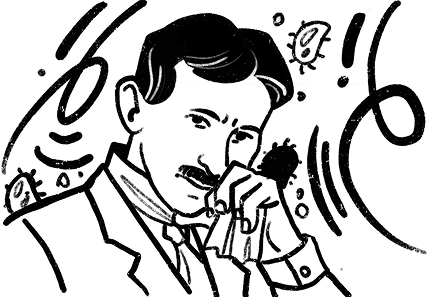
There’s no hard proof, but the coincidence is too perfect to ignore. Tesla’s revulsion toward “dirty connections” begs for a scientific metaphor. What if his mania for cleanliness became the springboard for his purest leap—the idea of wireless energy transmission? He hated wires with the same fervor he hated unwashed hands.
Perhaps, at that moment, he performed an elegant mental somersault worthy of a Halloween legend: Tesla began to build a world where energy travels without physical contact. Alternating current, the Tesla coil… It’s hard to wash away the thought that his psychological peculiarities were the secret fuel behind these breakthroughs.
A direct link between OCD and Wi-Fi? Too simplistic. But his nightmare of invisible threats strangely resonates with our world—where light, sound, and your messages fly through the air. And now the question remains: did Nikola Tesla conquer his fear, or merely realize it on a global scale?
THOMAS EDISON: THE PATENT ON LIGHT
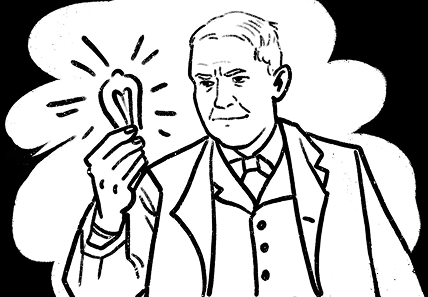
If Nikola Tesla was haunted by an invisible demon, Thomas Edison was tormented by humanity’s oldest and most tangible enemy—Darkness. But he was not one to believe in spells. A born pragmatist, Edison approached the banishment of night with a patent application—turning his childhood fear of darkness into a brilliant business plan. His lab at night resembled an alchemist’s forge. Instead of a philosopher’s stone, he sought a filament that could slay shadow itself.
Wasn’t that the most elegant exorcism ever? Edison performed the perfect murder: he bankrupted the dark. When the first commercial power station on Pearl Street came online in 1882, Edison didn’t just defeat darkness—he privatized it. He flooded basements and streets with light that could be switched on, switched off, and, most importantly, billed—“for the absence of darkness.”
His technological child forever altered the landscape of night, and for ghosts, appearing suddenly became unprofitable. Unviable.
OLIVER HEAVISIDE: THE HERMIT WHO FOUND THE SKY
While the world was stepping into the electrical age, Oliver Heaviside chose to step out of it. The genius of electromagnetism methodically buried himself alive. His house resembled a crypt: bricks sealed the windows, keeping the world out; the walls were covered in tar; instead of furniture stood granite blocks, like in a pharaoh’s tomb. Suffering from progressive deafness and, most likely, a personality disorder, Heaviside built the perfect bunker against reality. The irony worthy of Edgar Allan Poe awaited him right there.
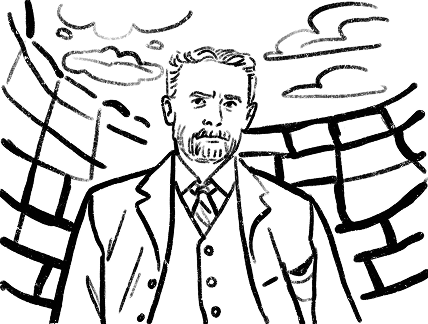
Entombed within four walls and obsessed with barriers, he inadvertently discovered the largest barrier on the planet—the one in the sky. In 1901, Guglielmo Marconi transmitted a signal across the Atlantic, defying physics: the waves should have escaped into space. Locked inside his shell, Heaviside found the answer—he hypothesized the existence of an invisible shield in the heavens, a layer that reflected radio waves. Later, it would be named the ionosphere.
Perhaps Heaviside’s manic passion for barriers created a unique mental lens. A mind craving absolute isolation sensed, with painful clarity, the need for a vast, natural barrier. So what remains in the end? A man fleeing from the world gave it a global voice. Or was it the world, mocking him, that granted the fugitive eternal connection with itself?
KAZUO TANAKA: THE SILENT HORROR OF THE BLURRED FRAME

The demons kept working in the new technological age. It all began with photographs taken by Kazuo Tanaka’s friend—they looked like death masks: the faces blurred, smiles faded like morning mist. Where life once was, only a thick, soundless stain remained, devouring the world. The friend was losing his sight and could no longer focus manually. Tanaka looked at those photos and heard the silence seep into him like an obsessive tune: an engineer accustomed to the order of blueprints confronted the chaotic flaw of the universe—the fragility of human flesh.
So he and his team resolved to attempt a technological resurrection—to replace the fading lens of the human eye with the soulless glass of an objective. And the miracle occurred. Cruel and imperfect. The first Canon AF35M autofocus worked; it was clumsy, more like a nervous twitch than a gaze, but it was genuine vision. The machine blinked its glass eye for the first time—and the world came into focus.
We’ve grown used to this mechanical eternal eye that lives in our phones, surveillance cameras, and car lenses. Sometimes, in silence, you can still hear its faint whisper—the echo of that same blurred frame that once frightened a single man. We created autonomous vision and gave darkness eyes. Now they watch us from everywhere. There is a strange, eerie beauty in that.
ARPA: THE NERVOUS SYSTEM OF A WORLD THAT COULD HAVE DIED
Some fears are too vast for one person to bear—they drift through the air of an entire era, becoming a shared hallucination of thousands of minds. In the 1960s, that fear was the dread of impending nuclear war.
Imagine a map where any point could be erased from the face of the Earth with surgical cynicism. The target was the brain itself—to destroy command centers and plunge a nation into an informational coma, where orders were never given, coordination collapsed, and then came the silence of strategic scale—a silence you could almost hear in the afterlife.
It was within this imagined echo of an impending explosion that the first digital web began to weave itself. The engineers of ARPA were given a task that would make any science fiction writer pale: to create an organism that could not be killed. The central principle of this idea sounded like blasphemy in an age of rigid discipline—to give the world salvation through chaos.
Data was broken into packets—a flock of digital carrier pigeons, each with a tiny fragment of the message. Every one of them was a stubborn individualist, flying its own route without asking permission from any center. If a new crater appeared in its path, the pigeon, without blinking a pixel, found a detour. The network truly lived—pulsing, searching, adapting. To kill it, one would have to incinerate all the pigeons at once—a task fit only for the most fastidious apocalypse.
Thus was born a system designed to outlive its creators. Conceived as a defensive reflex for the end of the world, it soon became the skeleton of the entire Internet. Today, this organism carries trillions of messages, transactions, and love confessions. The apparatus built to resist the silence of nuclear annihilation has become the source of humanity’s eternal, deafening, and beautiful noise.
THE ALCHEMY’S OUTCOME: A CONCLUSION FOR THE LABORATORY OF THE SOUL
So where do these stories lead us? To a strange yet tempting thought: personal demons are, perhaps, the best producers of genius projects.
Maybe it’s not about cause and effect, but about a unique mechanism: when the mind becomes fixated on a phobia, it begins to see peculiar possibilities where common sense sees only dead ends. One’s own fear turns into a toxic consultant—demanding the impossible, yet sometimes delivering brilliant, even mad ideas.
In everyday life, we use various inventions without realizing that, along with light bulbs and the internet, we’ve inherited something else—the creators’ own anxieties, woven into the very fabric of technology. Our world is illuminated by the shadows of its makers, and if you look closely, it’s within those shadows that the most fascinating message of the era is hidden.
A navigator determines the current location of a person on Earth. We’re mapping new routes in your consciousness.
Thank you!


